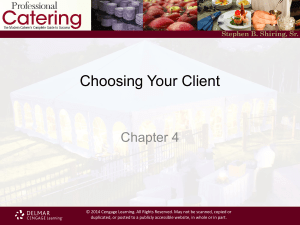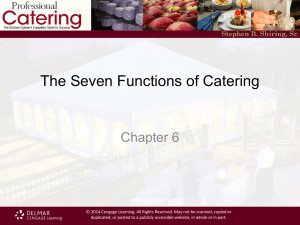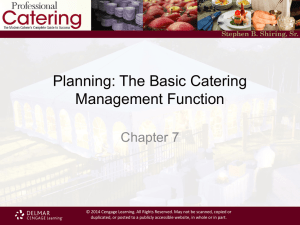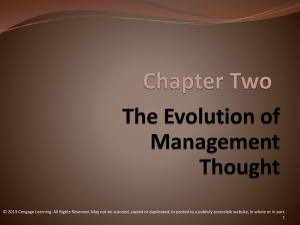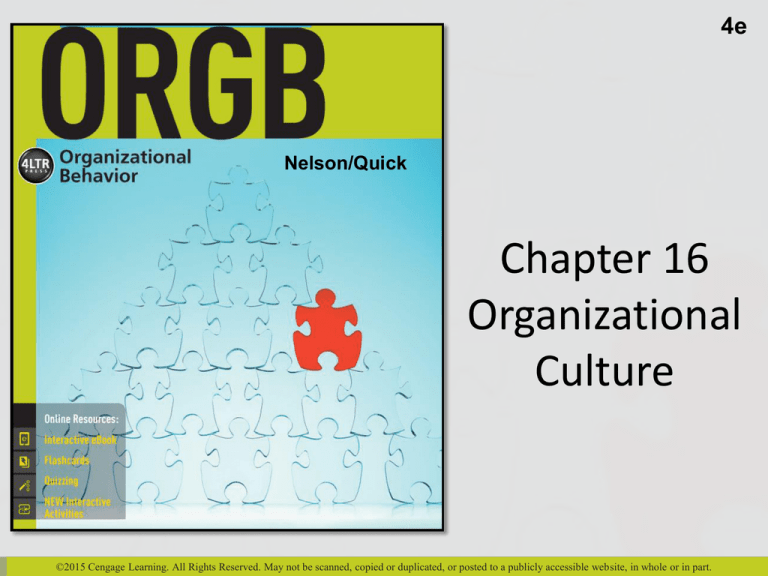
4e
Nelson/Quick
Chapter 16
Organizational
Culture
©2015 Cengage Learning. All Rights Reserved. May not be scanned, copied or duplicated, or posted to a publicly accessible website, in whole or in part.
Learning Outcomes
Identify the three levels of culture and the roles
they play in an organization
Evaluate the four functions of culture within an
organization
Explain the relationship between organizational
culture and performance
Describe five ways leaders reinforce organizational
culture
©2015 Cengage Learning. All Rights Reserved. May not be scanned, copied or duplicated, or posted to a publicly accessible website, in whole or in part.
2
Learning Outcomes
Describe the three stages of organizational
socialization and the ways culture is communicated
in each step
Discuss how managers assess their organization’s
culture
Explain actions managers can take to change
organizational culture
Identify the challenges organizations face
developing positive, cohesive cultures
©2015 Cengage Learning. All Rights Reserved. May not be scanned, copied or duplicated, or posted to a publicly accessible website, in whole or in part.
3
Figure 16.1 - Levels of Organizational
Culture
©2015 Cengage Learning. All Rights Reserved. May not be scanned, copied or duplicated, or posted to a publicly accessible website, in whole or in part.
4
Table 16.1 - Six Rites in Organizations
©2015 Cengage Learning. All Rights Reserved. May not be scanned, copied or duplicated, or posted to a publicly accessible website, in whole or in part.
5
Functions of Organizational Culture
Provides a sense of identity to members and
increases their commitment to the organization
Serves as a sense-making device for organization
members
Reinforces the values of the organization
Serves as a control mechanism for shaping
behavior
©2015 Cengage Learning. All Rights Reserved. May not be scanned, copied or duplicated, or posted to a publicly accessible website, in whole or in part.
6
Theories on the Relationship between
Organizational Culture and Performance
Strong culture perspective
• Organizational culture with a consensus on the values that
drive the company
Fit perspective
• Culture is good only if it fits the industry or the firm’s
strategy
Adaptation perspective
• Organizational culture that:
• Encourages confidence and risk taking among employees
• Has leadership that produces change
• Focuses on the changing needs of customers
©2015 Cengage Learning. All Rights Reserved. May not be scanned, copied or duplicated, or posted to a publicly accessible website, in whole or in part.
7
Table 16.2 - Adaptive versus
Nonadaptive Organizational Cultures
©2015 Cengage Learning. All Rights Reserved. May not be scanned, copied or duplicated, or posted to a publicly accessible website, in whole or in part.
8
Elements in Managing Culture
What leaders pay attention to
How leaders react to crises
How leaders behave
How leaders allocate rewards
How leaders hire and fire individuals
©2015 Cengage Learning. All Rights Reserved. May not be scanned, copied or duplicated, or posted to a publicly accessible website, in whole or in part.
9
Figure 16.2 - The Organizational Socialization
Process: Stages and Outcomes
©2015 Cengage Learning. All Rights Reserved. May not be scanned, copied or duplicated, or posted to a publicly accessible website, in whole or in part.
10
Organizational Culture Inventory
Focuses on behaviors that help employees fit
into the organization and meet coworker
expectations
Uses Maslow’s hierarchy of needs to measure
cultural styles
Four satisfaction cultural styles
Eight security cultural styles
©2015 Cengage Learning. All Rights Reserved. May not be scanned, copied or duplicated, or posted to a publicly accessible website, in whole or in part.
11
Kilmann-Saxton Culture-Gap Survey
Focuses on what happens in the organization and
the expectations of others
Underlying dimensions - Technical/human
orientation and short-term versus long-term time
Areas in which operating and ideal norms are
assessed
Task support
Task innovation
Social relationships
Personal freedom
©2015 Cengage Learning. All Rights Reserved. May not be scanned, copied or duplicated, or posted to a publicly accessible website, in whole or in part.
12
Triangulation
Use of multiple methods to measure organizational
culture
Some methods used to triangulate on the culture
Obtrusive observations by trained observers, which
provides an outsider perspective
Self-administered questionnaires, which provides
quantitative insider information
Personal interviews with the center’s staff, which
provides qualitative contextual information
©2015 Cengage Learning. All Rights Reserved. May not be scanned, copied or duplicated, or posted to a publicly accessible website, in whole or in part.
13
Figure 16.3 - Interventions for Changing
Organizational Culture
©2015 Cengage Learning. All Rights Reserved. May not be scanned, copied or duplicated, or posted to a publicly accessible website, in whole or in part.
14
Challenges to Developing Positive,
Cohesive Culture
Merger or Acquisition
Global organizational culture
Ethical organizational culture
Culture of empowerment and quality
©2015 Cengage Learning. All Rights Reserved. May not be scanned, copied or duplicated, or posted to a publicly accessible website, in whole or in part.
15





